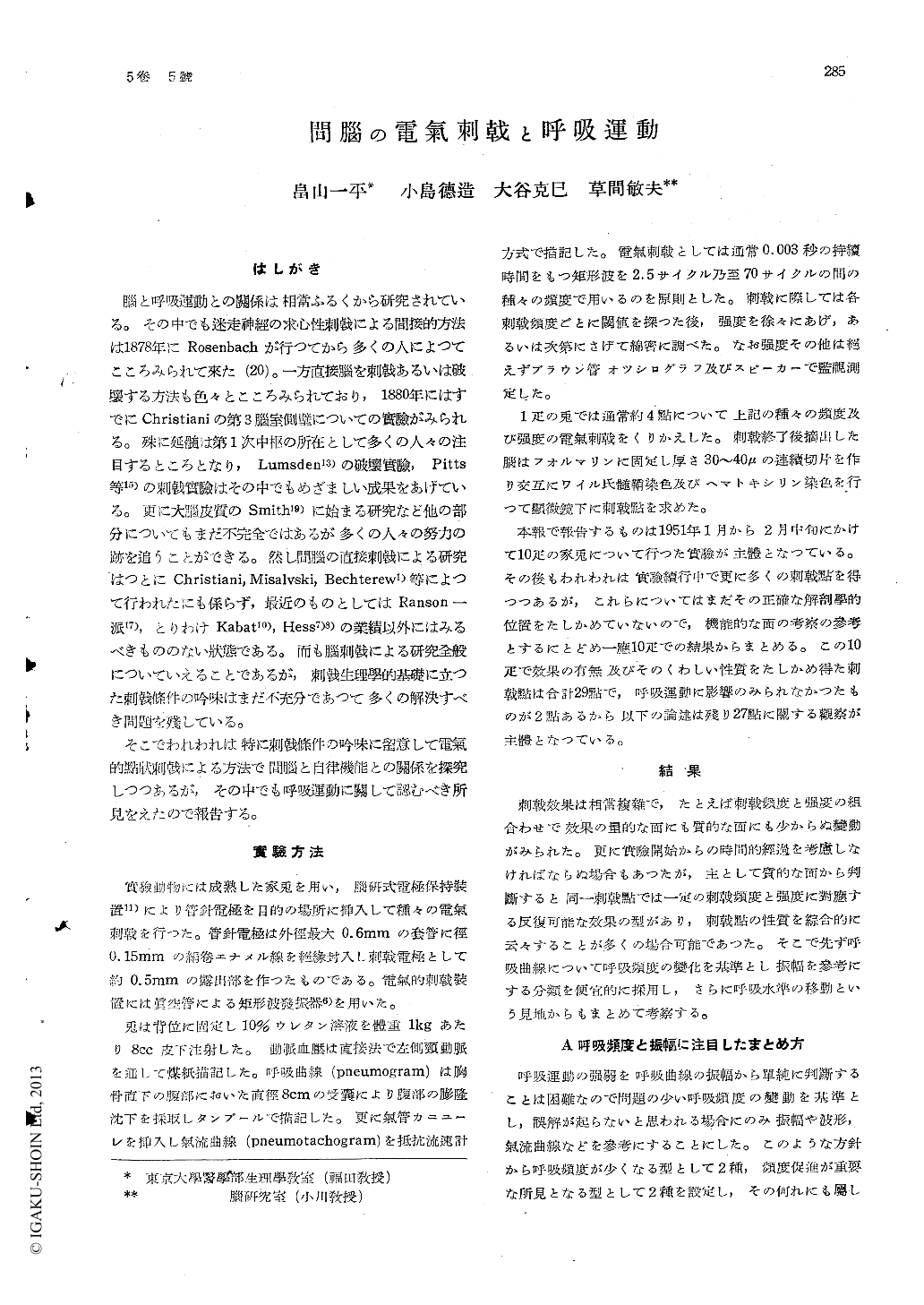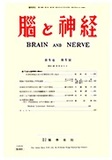Japanese
English
- 有料閲覧
- Abstract 文献概要
- 1ページ目 Look Inside
はしがき
腦と呼吸運動との關係は相當ふるくから研究されている。その中でも迷走神經の求心性刺戟による間接的方法は1878年にRosenbachが行つてから多くの人によつてこころみられて來た(20)。一方直接腦を刺戟あるいは破壞する方法も色々とこころみられており,1880年にはすでにChristianiの第3腦室側壁についての實驗がみられる。殊に延髄は第1次中枢の所在として多くの人々の注目するところとなり,Lumsden13)の破壞實驗,Pitts等15)の刺戟實驗はその中でもめざましい成果をあげている。更に大腦皮質のSmith19)に始まる研究など他の部分についてもまだ不完全ではあるが多くの人々の努力の跡を追うことができる。然し間腦の直接刺戟による研究はつとにChristiani, Misalvski, Bechterew1)等によつて行われたにも係らず,最近のものとしてはRanson一派17),とりわけKabat10), Hess7)8)の業績以外にはみるべきもののない状態である。而も腦刺戟による研究全般についていえることであるが,刺戟生理學的基礎に立つた刺戟條件の吟味はまだ不充分であつて多くの解決すべき問題を殘している。
そこでわれわれは特に刺戟條件の吟味に留意して電氣的點状刺戟による方法で間脳と自律機能との關係を探究しつつあるが,その中でも呼吸運動に關して認むべき所見をえたので報告する。
The respiratory effect of electric stimulation of diencephalon was studied in rabbit using a stereotaxic instrument,an electronic stimulator, both the authors' own device, and a needle ele-ctrode. The effect varied depending on elect-ric charactristics of stimuli, especially on the frequency and the intensity of the stimulus. Varions aspects of the modification of respira-tion caused by this procedure are analysed from the standpoint of stimulating condition, especil-ly electric characteristics of the stimuli appl-ied.
1) Inhibition of rate and amplitude of respira- tion. Increasing the frequency and the in- tensity of the stimulus, this inhibitory effect was enhanced and stimulation with high frequency and intensity often brought about complete suppression. Besides a shift of respiratory tonus level by changes in fre- quency and intensity of stimulus was induce- d in some cases.
2) The spasmodic inspiratory movement and intermittent inspiratory suppression. This effect was not much influenced by frequency and intensity of toe stimulus.
3) Accerelative effect independent on frequency and intensity of stimulative current. We could abtain this effect in many cases. It is considered that panting and paroxismal tachypnea may belong to the same category as these accerelative responses.
4) Considerable increase of rate and amplitude of respiration is produced by weak stimula- tion, while on the other hand increasing the strength of the stimulus, the effect on the amplitude is markedly inhibited. Neverth- less the accerelative effect of rate remains and becomes strengthened more and more and the strong stimuli bring out almost complete suppression.
5) A few cases that do not belong to the above mentioned our types were observed. These cases can also be explained from the condi- tion of frequency and intensity of electric stimulus.
We can also classify the effect on the respi-ratory tonus level with regard to frequency and intensity of stimulative current as follows.
1) Inspiratorye ffect with low frequency and intensity, and expiratory effect with high frequency and intensity.
2) Expiratory effect with low frequency and intensity, and inspiratory effect with high frequency and intensity, in contrast to the preceding case.
3) Inspiratory effect throughout.
4) Expiratory effect throughout.
5) Irregular effect.
The respective localisation of the stimulated points for each of the above classified effect could not be called closely confined. They were not at random in distribution, and we could rather indicate a certain degree of regu-larity in the distribution of the stimulated points more or less closely grouped among themselves for each type of responses. In the authors' opinion it is not secure to discuss the function of the brain simply relying on a con-ventional way of stimulation by means of a crude apparatus of electric stimulation.

Copyright © 1953, Igaku-Shoin Ltd. All rights reserved.


